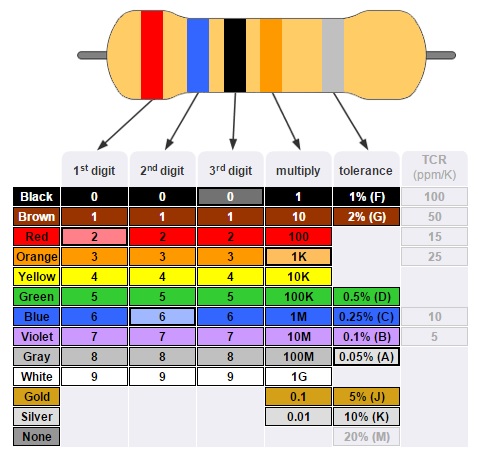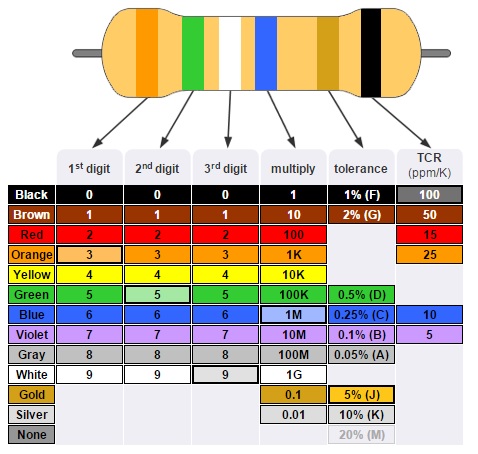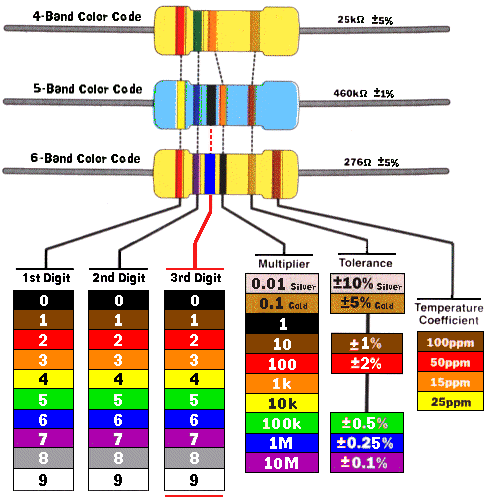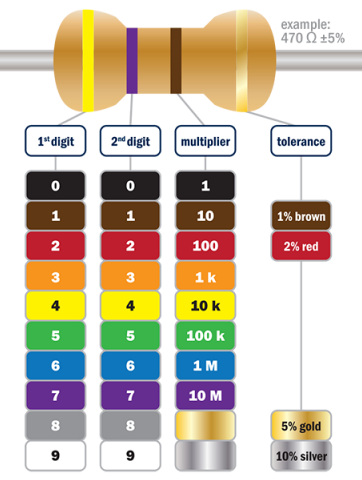10k resistor color code meaning
This calculator will help you identify the value tolerance and temperature coefficient of a color coded resistor by simply selecting the bands colors. The use of color codes has been extended to abstractions such as the Homeland Security Advisory System color code in the United States.

Resistor Color Code And Variable Resistor
4- Band Code 5- Band Code RESISTOR COLOR CODE GUIDE 2 0 x10000 10 20 x 10000 200000 1000 1K Resistor 200 K with a 10 Tolerance-First Band Second Band Multiplier Band Tolerance Band Equation The Gold or Silver band is always placed to the right.

. 196 1 Ω 01 Failure Rate. 10KΩ Resistor Color Code. The colour code used to denote the tolerance rating of a resistor is given as.
1st band Brown 1 1st digit 2nd band Black 0 2nd digit 3rd band Black 1 multiplier 4th band Gold 5 tolerance Therefore 10 15 10Ω 10Ω. In this case the third band is red which corresponds to the number 2. This calculator supports resistors with 3 4 5 and 6 bands.
If you have a resistor with a gold or silver band on one end you have a 5 or 10 tolerance resistor. On a 5 and 6 band the first three bands are the significant digits. Brown Black Blue Gold.
4 Band Colour Code. Band 1 First digit value of resistor Band 2 Second digit value of resistor. Therefore the multiplier is 10 2 100.
So the total value of the resistance given by the colors is 10 x 10 2 Ω 1000 Ω 1kΩ. 47 times 100 is 4700. Gives the value of the tolerance for the resistor.
Q1 Determine the resistance of the given resistor with the given colour sequence Red Green Red Gold. Ad Digi-Key Electronics - Authorized Electronic Component Distributor. A 205 Ω 1 tolerance resistor would be marked as Red Black Green Gold Brown.
The 47kΩ resistor has color bands of yellow and violet to begin which have digit values of 4 and 7 47. - Basic resistor values range from 01 Ohm to 10 Megaohms. As in the above 4 band example the first two bands are red and purple representing 2 and 7.
As we know the first two colours represent the significant digits of resistance value so the given colours represent digits 2 and 5. The first band is denoting number 1 the second one to 0 and the third one to 1000. On a 4 band resistor the first two bands represent the significant digits.
The standard color coding method for resistors uses a different color to represent each number 0 to 9. This gives a value of 27 1000 or. Decoding Resistor Color Bands When decoding the resistor color bands consult a resistor color code table like the one below.
On a 5 and 6 band the first three bands are the significant digits. The resistor value is read from the left to right. Looking at tabl1 1Brown.
Here is a handy-dandy resistor color band. The next band represents the multiplier or decade. The actual multiplier is 10 n where n is the value of the band color.
And tolerance considered as 5of10 05Ω. If youre trying to commit the color band code to memory a mnemonic device might help. 100Ω Resistor Color Code up 10MΩ Resistor Color Code.
See the Digi-Key Difference Today. Let we want to find out the Resistance of the 10K ohm Resistance. So the Resistor will have the color code as Brown-Black-Orange.
If you are a. With that knowledge realize that on a four-band resistor the third color will. Brown 1 Red 2 Gold 5 Silver 10 If resistor has no fourth tolerance band then the default.
Black brown red orange yellow green blue purple gray white. The third band is orange representing 3 meaning 10 3 or 1000. The third band is a multiplier band.
For the 6 band resistor example shown above. This means that for a temperature change of 10 C the resistance value can change 1000 ppm 01. Resistor Color Code 10k resistor has the color code brownblackorangegold.
You might also find resistors marked with 4 bands for resistance where the first 3 bands are significant digits and the 4th band is the multiplier. 196 Ω 01 Failure Rate. It will also calculate the minimum and maximum values based on the tolerance ratio.
The most common color for the sixth band is brown 100 ppmC. Hence the colour red represents a multiplier factor of 10 2. We were unable to load Disqus.
Band Four Tolerance. On a 4 band resistor the first two bands represent the significant digits. Brown Black Orange Gold.
Orange 3 red 2 brown 1 brown x10 green 1 red 50 ppmC represents a 321 kΩ resistor with a 1 tolerance and a 50. Here to Support You From Prototype to Production. 4 Band Colour Code.
The third band of the 47kΩ is red which indicates that the 47 should be multiplied by 10 2 or 100. Thus the actual value of the 1 kilo ohm can be between 950 ohms and 1050 ohms. Thus the value of the resistance to the corresponding color code is 10100 1000 ohms or 1 kilo ohm with the tolerance band being Gold which represents a tolerance of - 5.
4What do the colors on resistors mean. Position the resistor with this band on the right side and again read your resistor from left to right. The third band is orange representing 3 meaning 10 3 or 1000.

Resistor Color Code Chart How To Identify Resistance Color Coding Color Coding Coding Electronic Schematics

10k Ohm Resistor Color Code Wira Electrical

Resistor Color Code Calculator Tools Utmel
Resistors And The Color Codes Hirophysics

Resistor Color Code Table Smd Resistor Code

Resistor Color Code Explained By Electronzap For 1k And 10k Beige And Blue Resistors Youtube

Resistor Color Codes Explained 4 Band Resistors And 5 Band Resistors
10k Ohm Resistor Color Code Wira Electrical

Resistor Color Code 4 Band 5 Band And 6 Band Resistors

Resistor Color Code Calculator Tools Utmel

Resistor Color Code Calculator Tools Utmel

Resistor Color Code Table Smd Resistor Code Resistors Resistor Coding

Resistor Color Code Table Smd Resistor Code
Resistors And The Color Codes Hirophysics

Resistor Color Code Calculator Tools Utmel



